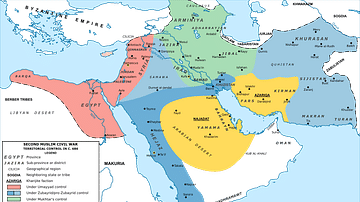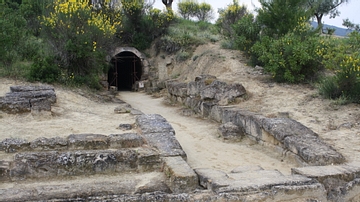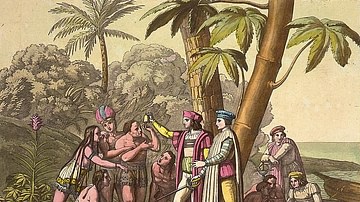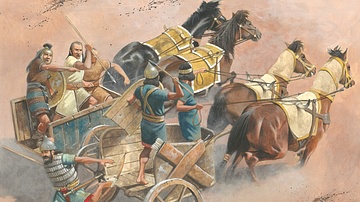Search
Search Results

Image
Map of the Middle East during the Second Fitna (c. 686 CE)
A map depicting the divisions of the Islamic Empire during the second Islamic civil war - the Second Fitna. The dominions of the Umayyads, Zubayrids, Kharjites, Al Mukhtar and those regained by the Byzantines are shaded in colors as indicated...
![Throne Dais of Shalmaneser III [South Face, East End]](https://www.worldhistory.org/img/c/p/360x202/10531.jpg?v=1618584310)
Image
Throne Dais of Shalmaneser III [South Face, East End]
This scene is part of a long tributary one where the Shalmaneser III (r. 858-824 BCE) receives Chaldean tribute from Musallim-Marduk, son of Ukani. On the right, a groom leads a pair of horses, unharnessed except for the halter by which...
![Throne Dais of Shalmaneser III [North Face, East End]](https://www.worldhistory.org/img/c/p/360x202/10523.jpg?v=1618801204)
Image
Throne Dais of Shalmaneser III [North Face, East End]
This scene is part of a long tributary one where the king receives tribute from Qalparunda of the Land of Unqi (a Luwian Syri-Hittite state, also known as Pattin). Here, the Assyrian king, Shalmaneser III (r. 858-824 BCE), stands below a...
![Throne Dais of Shalmaneser III [South Face, East End]](https://www.worldhistory.org/img/c/p/360x202/10530.jpg?v=1599153303)
Image
Throne Dais of Shalmaneser III [South Face, East End]
This scene is part of a long tributary one where the Shalmaneser III (r. 858 - 824 BCE) receives Chaldean tribute from Musallim-Marduk, son of Ukani. The procession is headed by a bearded male figure (probably the prince). Before him...

Image
Stadium Entrance Tunnel (East End), Nemea, Greece
Constructed in 330-320 BCE, the entrance to the stadium is mostly hidden from view from the spectators in the stadium and the athletes entrance would have been all the more dramatic.

Article
Native American Enslavement in Colonial America
Slavery was practiced by the Native Americans before any Europeans arrived in the region. People of one tribe could be taken by another for a variety of reasons but, whatever the reason, it was understood that the enslaved had done something...
![Chogha Zanbil Ziggurat [East Side], Iran](https://www.worldhistory.org/img/c/p/360x202/10670.jpg?v=1702536009)
Image
Chogha Zanbil Ziggurat [East Side], Iran
View of the east side of the ziggurat of Chogha Zanbil with the southeastern stairway which provided access to the first terrace. Chogha Zanbil is a magnificent, 3300-year-old ancient Elamite complex located 30 kilometres south-east of the...

Image
Chariot Warfare in the Ancient Near East
An illustration of what chariot warfare looked like in the ancient Near East. Illustration by by Zvonimir Grbasic.

Image
Parthenon, East Facade
East facade of the Parthenon, Athens, 5th century BCE.

Image
The Near East in 1135 CE
This map of the Near East in 1135 CE shows four Crusader States (marked with red crosses) in relation to other powerful kingdoms in the period between the first and second crusades.